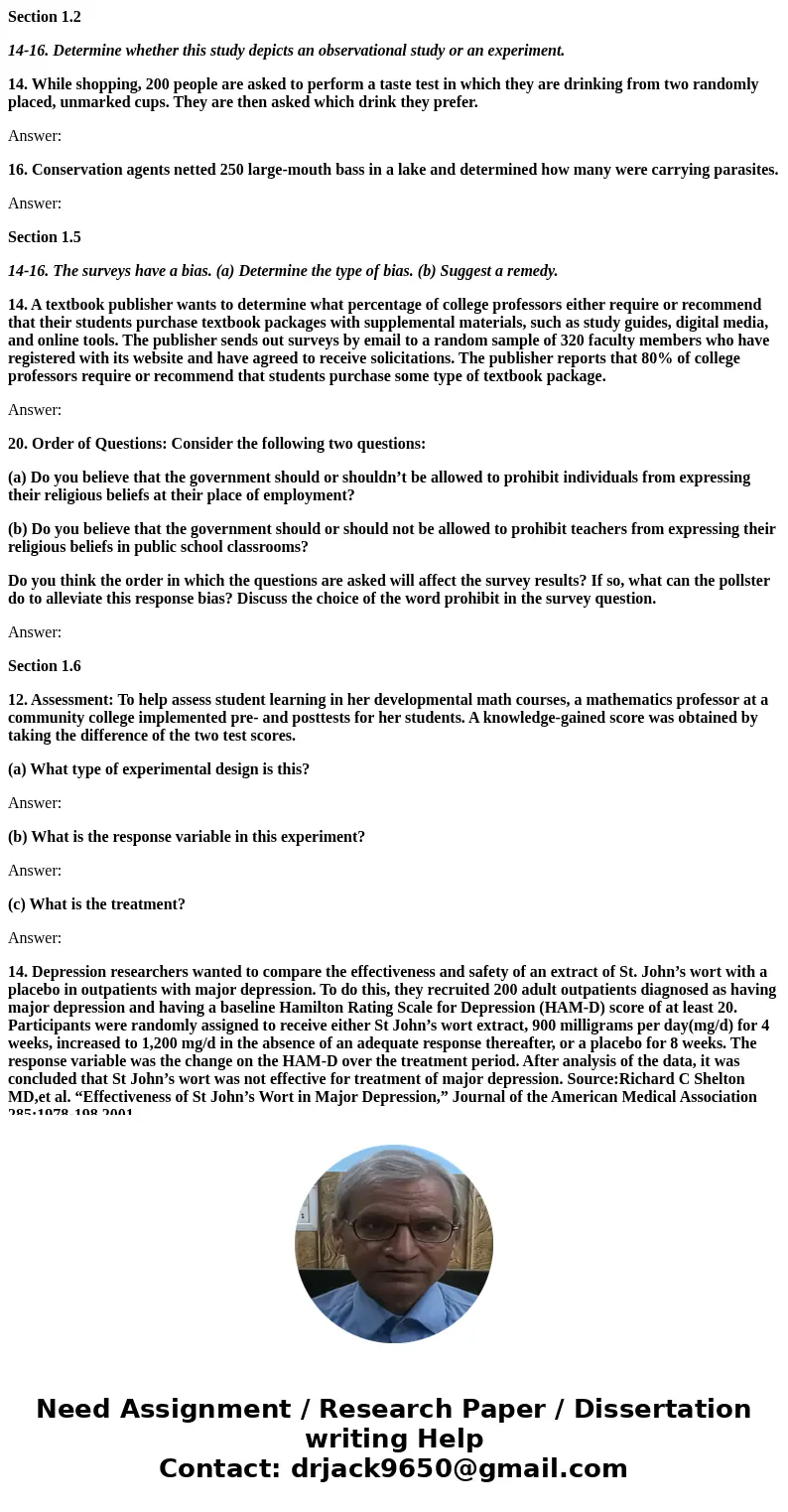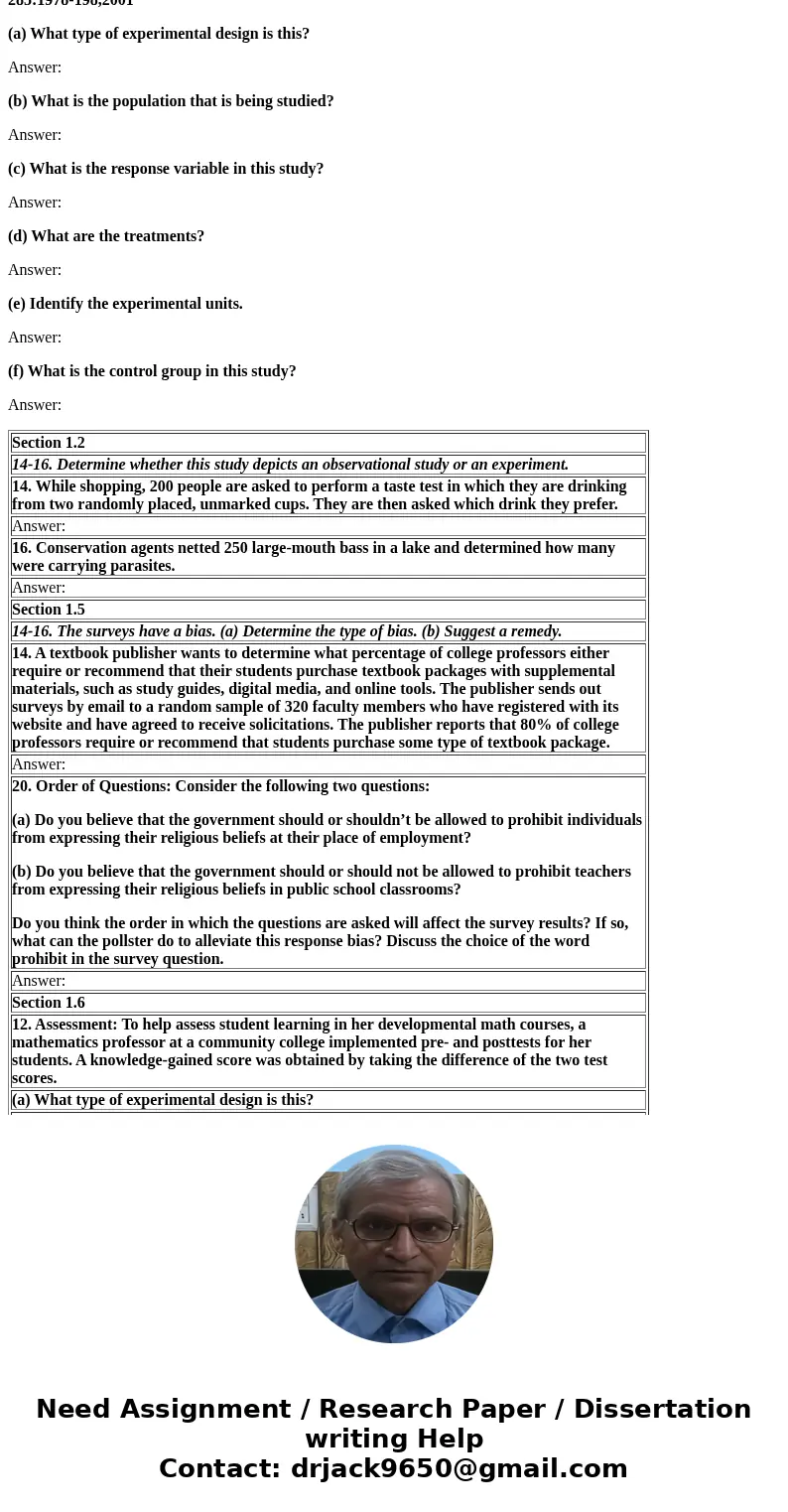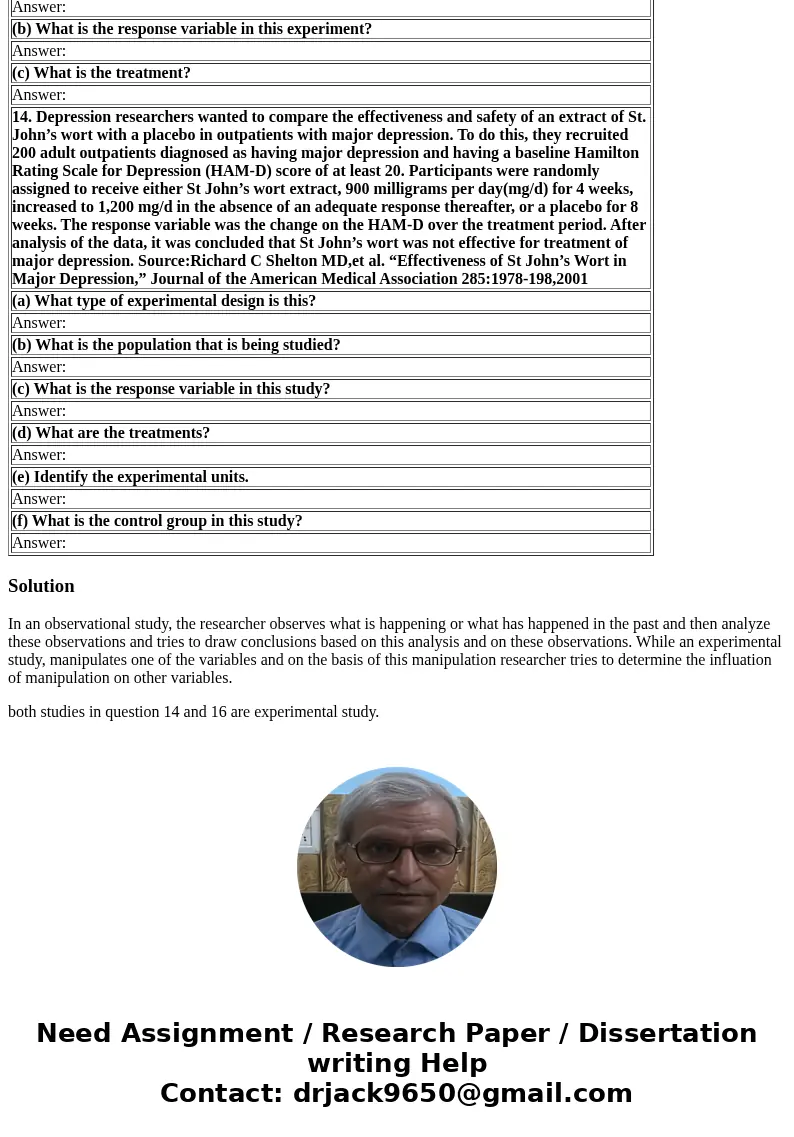Section 12 1416 Determine whether this study depicts an obse
Section 1.2
14-16. Determine whether this study depicts an observational study or an experiment.
14. While shopping, 200 people are asked to perform a taste test in which they are drinking from two randomly placed, unmarked cups. They are then asked which drink they prefer.
Answer:
16. Conservation agents netted 250 large-mouth bass in a lake and determined how many were carrying parasites.
Answer:
Section 1.5
14-16. The surveys have a bias. (a) Determine the type of bias. (b) Suggest a remedy.
14. A textbook publisher wants to determine what percentage of college professors either require or recommend that their students purchase textbook packages with supplemental materials, such as study guides, digital media, and online tools. The publisher sends out surveys by email to a random sample of 320 faculty members who have registered with its website and have agreed to receive solicitations. The publisher reports that 80% of college professors require or recommend that students purchase some type of textbook package.
Answer:
20. Order of Questions: Consider the following two questions:
(a) Do you believe that the government should or shouldn’t be allowed to prohibit individuals from expressing their religious beliefs at their place of employment?
(b) Do you believe that the government should or should not be allowed to prohibit teachers from expressing their religious beliefs in public school classrooms?
Do you think the order in which the questions are asked will affect the survey results? If so, what can the pollster do to alleviate this response bias? Discuss the choice of the word prohibit in the survey question.
Answer:
Section 1.6
12. Assessment: To help assess student learning in her developmental math courses, a mathematics professor at a community college implemented pre- and posttests for her students. A knowledge-gained score was obtained by taking the difference of the two test scores.
(a) What type of experimental design is this?
Answer:
(b) What is the response variable in this experiment?
Answer:
(c) What is the treatment?
Answer:
14. Depression researchers wanted to compare the effectiveness and safety of an extract of St. John’s wort with a placebo in outpatients with major depression. To do this, they recruited 200 adult outpatients diagnosed as having major depression and having a baseline Hamilton Rating Scale for Depression (HAM-D) score of at least 20. Participants were randomly assigned to receive either St John’s wort extract, 900 milligrams per day(mg/d) for 4 weeks, increased to 1,200 mg/d in the absence of an adequate response thereafter, or a placebo for 8 weeks. The response variable was the change on the HAM-D over the treatment period. After analysis of the data, it was concluded that St John’s wort was not effective for treatment of major depression. Source:Richard C Shelton MD,et al. “Effectiveness of St John’s Wort in Major Depression,” Journal of the American Medical Association 285:1978-198,2001
(a) What type of experimental design is this?
Answer:
(b) What is the population that is being studied?
Answer:
(c) What is the response variable in this study?
Answer:
(d) What are the treatments?
Answer:
(e) Identify the experimental units.
Answer:
(f) What is the control group in this study?
Answer:
| Section 1.2 |
| 14-16. Determine whether this study depicts an observational study or an experiment. |
| 14. While shopping, 200 people are asked to perform a taste test in which they are drinking from two randomly placed, unmarked cups. They are then asked which drink they prefer. |
| Answer: |
| 16. Conservation agents netted 250 large-mouth bass in a lake and determined how many were carrying parasites. |
| Answer: |
| Section 1.5 |
| 14-16. The surveys have a bias. (a) Determine the type of bias. (b) Suggest a remedy. |
| 14. A textbook publisher wants to determine what percentage of college professors either require or recommend that their students purchase textbook packages with supplemental materials, such as study guides, digital media, and online tools. The publisher sends out surveys by email to a random sample of 320 faculty members who have registered with its website and have agreed to receive solicitations. The publisher reports that 80% of college professors require or recommend that students purchase some type of textbook package. |
| Answer: |
| 20. Order of Questions: Consider the following two questions: (a) Do you believe that the government should or shouldn’t be allowed to prohibit individuals from expressing their religious beliefs at their place of employment? (b) Do you believe that the government should or should not be allowed to prohibit teachers from expressing their religious beliefs in public school classrooms? Do you think the order in which the questions are asked will affect the survey results? If so, what can the pollster do to alleviate this response bias? Discuss the choice of the word prohibit in the survey question. |
| Answer: |
| Section 1.6 |
| 12. Assessment: To help assess student learning in her developmental math courses, a mathematics professor at a community college implemented pre- and posttests for her students. A knowledge-gained score was obtained by taking the difference of the two test scores. |
| (a) What type of experimental design is this? |
| Answer: |
| (b) What is the response variable in this experiment? |
| Answer: |
| (c) What is the treatment? |
| Answer: |
| 14. Depression researchers wanted to compare the effectiveness and safety of an extract of St. John’s wort with a placebo in outpatients with major depression. To do this, they recruited 200 adult outpatients diagnosed as having major depression and having a baseline Hamilton Rating Scale for Depression (HAM-D) score of at least 20. Participants were randomly assigned to receive either St John’s wort extract, 900 milligrams per day(mg/d) for 4 weeks, increased to 1,200 mg/d in the absence of an adequate response thereafter, or a placebo for 8 weeks. The response variable was the change on the HAM-D over the treatment period. After analysis of the data, it was concluded that St John’s wort was not effective for treatment of major depression. Source:Richard C Shelton MD,et al. “Effectiveness of St John’s Wort in Major Depression,” Journal of the American Medical Association 285:1978-198,2001 |
| (a) What type of experimental design is this? |
| Answer: |
| (b) What is the population that is being studied? |
| Answer: |
| (c) What is the response variable in this study? |
| Answer: |
| (d) What are the treatments? |
| Answer: |
| (e) Identify the experimental units. |
| Answer: |
| (f) What is the control group in this study? |
| Answer: |
Solution
In an observational study, the researcher observes what is happening or what has happened in the past and then analyze these observations and tries to draw conclusions based on this analysis and on these observations. While an experimental study, manipulates one of the variables and on the basis of this manipulation researcher tries to determine the influation of manipulation on other variables.
both studies in question 14 and 16 are experimental study.



 Homework Sourse
Homework Sourse